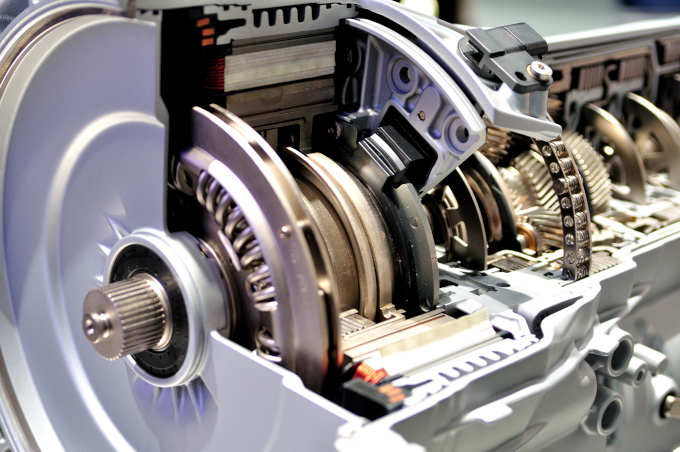A transmission fluid flush is an important aspect of transmission maintenance. Clean, functional transmission fluid ensures your gears can change smoothly to avoid wear and overheating. So, it’s crucial to maintain optimum fluid levels and keep a close eye on the condition of the fluid.
At the end of this article, you’d know everything you need to know about a transmission flush.
- What is a transmission flush?
- Flush vs. fluid change
- Benefits
- Procedure
What Is a Transmission Flush?
Simply put, a transmission flush completely replaces the existing fluid inside your transmission. You remove as much oil as possible and the impurities inside the transmission and refill it with clean, new transmission fluid.
Some professionals recommend running a detergent solution through your transmission lines.
This service will help you get every bit of dirt and grime lodged in your transmission. This procedure requires a particular machine that pressurizes and moves the detergent solution through your transmission. Detergent is not compulsory, but it does help to clean your transmission thoroughly. Once you have completely removed the existing fluid, you can refill it with clean, new transmission oil.
Difference Between a Flush and a Fluid Change
The terms fluid flush and fluid change seem to be identical. Though they are similar, they represent two different procedures.
A transmission fluid change involves draining dirty fluid from the pan, while a fluid flush is when fluid is removed and replaced in the pan, torque converter, and cooler lines.
A transmission fluid change takes less time and is more cost-effective than a fluid flush. But with a fluid change, you won’t get all the contaminants out of your transmission.
On the other hand, a fluid flush is pricier and takes longer (a few hours compared to 30 minutes for a change) but will get more than 80% of the contaminants out of your transmission.
Benefits of a Transmission Flush
Here is a look at the benefits you get by performing a transmission flush:
Prevents Damage
Brand new fluid from a flush compared to a regular fluid change will provide more effective lubrication. Inside your transmission, multiple gears and other metal components constantly grind against each other, causing extensive wear and possible chippings. This is where lubrication comes in. Lubrication will significantly reduce wear and protect your transmission from chipping or overheating. The additional lubrication offered by new transmission oil will protect your vehicle from damage that old oil cannot protect you from.
Increases Efficiency
Transmission fluid plays a huge role in the performance of the transmission. It allows the gears inside to move smoothly, keeping the transmission cool and functioning at its best. It also prevents sluggish gear response, enabling you to operate the vehicle efficiently.
Apart from the increased transmission performance, it will also improve the engine's performance. As a result, your vehicle will be more fuel efficient.
Increases Transmission Lifespan
Fluid changes will not remove debris and other impurities inside the transmission. The impurities flowing with your fluid or lodged along the transmission will slowly chip away at your transmission's health. Removing these impurities is the best way to increase the transmission's lifespan.
When To Do a Transmission Flush
A transmission flush is a part of routine maintenance that your vehicle requires. This is not a solution to an existing problem with your transmission. If you notice transmission issues, a trained technician must look at your transmission before conducting services. The longer these symptoms go, the greater risk for transmission damage or failure.
Worrisome symptoms include:
- If you notice leaks, take your vehicle immediately to a professional.
- Slipping gears
- Vehicle surges or stalls soon after shifting gears.
- Shifting requires more force than usual.
- Strange noises are coming from the transmission.
So, how often do you need a transmission flush? Your owner’s manual will be the most helpful when looking at maintenance intervals for getting a fluid change for your transmission. These intervals can vary widely depending on the make, model, and year of the vehicle, as well as driving habits.
Here are a few indications that you should up the fluid maintenance on your vehicle’s transmission in Southern California:
- If you take a lot of daily short trips under 10 miles
- If you regularly tow a boat
- If you haul other heavy loads for work or pleasure
If you have questions, see a transmission expert.
Transmission Flush Is Not a DIY Maintenance Item
We recommend you take your vehicle to a transmission specialist to get a transmission flush done. Why? If done incorrectly, a botched transmission flush could permanently damage your transmission.
Sometimes a transmission flush should not be conducted, especially if your vehicle has not been regularly serviced or the transmission fluid has not been maintained or changed on schedule. If there is a substantial buildup of debris, a transmission flush could force chunks of metal and debris from one end of the transmission through to the other. The traveling dirt and debris may block one-way valves or narrow channels, interrupting the flow and potentially causing serious problems in the future. A well-trained technician can discuss the best course of action in this circumstance.
Another rookie mistake is using strong detergents to clean the transmission. Some chemicals are so potent that they damage sensors and some internal seals.
Additionally, the trained eye of a specialized technician can diagnose the state of your transmission by examining the fluid. For example, there is a difference between dirty transmission fluid and burnt transmission fluid. Though they look the same, a transmission expert can easily spot the differences. If your technician notices that burnt transmission fluid, they know that your transmission is overheating, and other interventions may be needed. Similarly, a technician can diagnose other problems that your transmission might be experiencing.
Questions about Transmission Flushes? Ask Us!
If you're unsure whether you need a transmission flush, AAMCO Centers of Southern California can help. Our exclusive Power Purge® and Power Purge® Plus Transmission Flush (Fluid Exchange) services are thorough and affordable, and they can help improve your vehicle’s performance and fuel economy. So if you're experiencing problems with your transmission or just want to maintain optimal performance, let us help you get the most out of your car. We also offer a wide range of transmission services, from flushes to rebuilds, and our experts can answer any questions you may have about your car's transmission. Call us today!
AAMCO has more than 60 years of experience diagnosing, servicing, and repairing more than 20 million vehicles. Customers rely on us for:
- Quality repairs
- Expert technicians
- Superior customer experience
- Trustworthy, honest service
- Best warranty coverage available
AAMCO Centers of Southern California and surrounding areas represent trust, quality, and value.

 Schedule Appointment
Schedule Appointment















